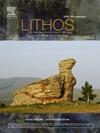Discovery of ca. 2.33–2.22 Ga magmatic activities in the Longshan Complex bordering the southwestern margin of the North China Craton: Implications for tectonic transformation
IF 2.5
2区 地球科学
Q2 GEOCHEMISTRY & GEOPHYSICS
引用次数: 0
Abstract
The 2.45–2.20 Ga in the early Paleoproterozoic, known as the tectono-magmatic lull, was marked by a decline in global continental magmatism and orogenic activity. This study is the first to identify ca. 2.33–2.30 Ga tonalite–trondhjemite–granodiorite (TTG) gneisses (2325 ± 23 Ma, 2296 ± 22 Ma) and ca. 2.25–2.22 Ga TTG gneisses (2246 ± 19 Ma, 2242 ± 23 Ma, 2217 ± 24 Ma) in the Zhangjiachuan area of the Longshan Complex, located along the southwestern margin of the North China Craton (NCC). All TTG gneisses exhibit high SiO2 and Na2O concentrations but relatively low K2O and MgO concentrations. The ca. 2.33–2.30 Ga TTG gneisses have medium to high Yb (0.78–2.94 ppm) and Y (11.16–28.01 ppm) concentrations, along with flat heavy rare-earth element patterns, suggesting that amphibole and/or garnet were the residual phases during partial melting under medium-pressure conditions. Their moderate Sr (225–437 ppm) concentrations and predominantly negative Eu anomalies (δEu = 0.61–0.93) further imply the presence of plagioclase in the residue. Alternatively, the ca. 2.25–2.22 Ga TTG gneisses exhibit low Yb (0.27–1.06 ppm) and Y (3.84–12.31 ppm) concentrations, positive or negligible Eu anomalies (δEu = 0.96–1.55), and higher Sr (333–1095 ppm) concentrations, indicating garnet and amphibole as the residual phases under high-pressure conditions. The lower Mg# (28–44), Cr (3.04–34.70 ppm), and Ni (2.83–5.45 ppm) concentrations suggest that the ca. 2.33–2.30 Ga TTG gneisses formed through the partial melting of the lower continental crust. Conversely, the higher Mg# (46–52) but lower Cr (6.03–16.67 ppm) and Ni (6.22–15.97 ppm) concentrations in the ca. 2.25–2.22 Ga TTG gneisses may indicate interaction with mafic melts from the mantle. The ca. 2.33–2.22 Ga TTG gneisses display εHf(t) values ranging from −6.6 to +4.7 and TDM2 ages of 3.29 to 2.55 Ga, closely resembling those of the ca. 2.30 Ga TTG gneisses found in the southern NCC, suggesting that the ca. 2.33–2.22 Ga TTG gneisses originally formed in the southern NCC. Crust thickness calculations indicate a gradual thickening from 2.35 to 2.30 Ga, followed by a gradual decrease after 2.30/2.26 Ga in the southern NCC. This region experienced mafic–granitic magmatism during the early Paleoproterozoic, likely triggered by magmatic underplating—a process that facilitated mafic material injection into the lower crust, leading to progressive crustal thickening. Concurrently, the migration of intermediate-felsic magmas may have contributed to crustal densification. The combined effects of crustal thickening and densification could have induced lower crustal delamination, potentially explaining the observed post 2.30/2.26 Ga crustal thinning. The ca. 2.25–2.22 Ga TTG gneisses also exhibit geochemical characteristics indicative of interaction with mafic melts from the mantle. Thus, the southern NCC experienced a tectonic transition during the early Paleoproterozoic, evolving from crustal thickening induced by magmatic underplating to extensional tectonics driven by delamination.
华北克拉通西南缘龙山杂岩约2.33-2.22 Ga岩浆活动的发现及其构造转化意义
早古元古代2.45-2.20 Ga为构造岩浆间歇期,标志着全球大陆岩浆活动和造山活动的减弱。在华北克拉通西南缘龙山杂岩张家川地区首次发现了约2.33 ~ 2.30 Ga的TTG片麻岩(2325±23 Ma, 2296±22 Ma)和约2.25 ~ 2.22 Ga的TTG片麻岩(2246±19 Ma, 2242±23 Ma, 2217±24 Ma)。所有TTG片麻岩均表现出高SiO2和Na2O浓度,而相对较低的K2O和MgO浓度。ca. 2.33-2.30 Ga TTG片麻岩具有中高Yb (0.78-2.94 ppm)和Y (11.16-28.01 ppm)浓度,以及扁平的重稀土元素模式,表明角闪洞和/或石榴石是中压条件下部分熔融的残余相。Sr (225 ~ 437 ppm)浓度适中,Eu (δEu = 0.61 ~ 0.93)呈负异常,进一步表明该沉积物中存在斜长石。另外,ca. 2.25-2.22 Ga TTG片麻岩表现出低Yb (0.27-1.06 ppm)和Y (3.84-12.31 ppm)浓度,正或可忽略的Eu异常(δEu = 0.96-1.55)和较高的Sr (333-1095 ppm)浓度,表明高压条件下残留相为石榴石和角闪孔。Mg#(28 ~ 44)、Cr (3.04 ~ 34.70 ppm)和Ni (2.83 ~ 5.45 ppm)浓度较低,表明ca. 2.33 ~ 2.30 Ga TTG片麻岩是由下陆壳部分熔融形成的。相反,2.25 ~ 2.22 Ga TTG片麻岩中Mg#(46 ~ 52)浓度较高,Cr (6.03 ~ 16.67 ppm)和Ni (6.22 ~ 15.97 ppm)浓度较低,可能与地幔基性熔体相互作用。ca. 2.33 ~ 2.22 Ga TTG片麻岩的εHf(t)值为- 6.6 ~ +4.7,TDM2年龄为3.29 ~ 2.55 Ga,与NCC南部发现的ca. 2.30 Ga TTG片麻岩非常相似,表明ca. 2.33 ~ 2.22 Ga TTG片麻岩最初形成于NCC南部。地壳厚度计算表明,在2.35 ~ 2.30 Ga期间,地壳厚度逐渐变厚,在2.30 ~ 2.26 Ga之后,地壳厚度逐渐减小。该地区在古元古代早期经历了基性花岗岩岩浆活动,可能是由岩浆下板块引发的,这一过程促进了基性物质注入下地壳,导致地壳逐渐变厚。同时,中长英岩浆的迁移也可能导致了地壳的致密化。地壳增厚和致密的共同作用可能导致了地壳的下分层,这可能解释了2.30/2.26 Ga后地壳变薄的现象。约2.25-2.22 Ga TTG片麻岩也表现出与地幔基性熔体相互作用的地球化学特征。因此,北中陆块南部在早古元古代经历了构造转型,由岩浆底沉积引起的地壳增厚演变为拆沉驱动的伸展构造。
本文章由计算机程序翻译,如有差异,请以英文原文为准。
求助全文
约1分钟内获得全文
求助全文
来源期刊

Lithos
地学-地球化学与地球物理
CiteScore
6.80
自引率
11.40%
发文量
286
审稿时长
3.5 months
期刊介绍:
Lithos publishes original research papers on the petrology, geochemistry and petrogenesis of igneous and metamorphic rocks. Papers on mineralogy/mineral physics related to petrology and petrogenetic problems are also welcomed.
 求助内容:
求助内容: 应助结果提醒方式:
应助结果提醒方式:


